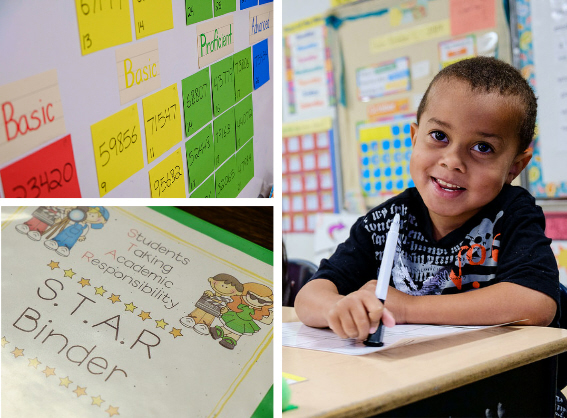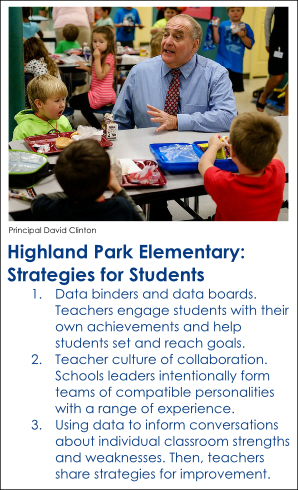There’s a scoreboard in every fourth-grade classroom at 2014 SCORE Prize finalist Highland Park Elementary in Lenoir City.
Sure, the displays could also be called data boards. But Principal David Clinton, a former high school football coach, likes to infuse the school’s data-rich culture with language that is both motivating and meaningful. Highland Park staff and students are reminded to think like a team with a three-game season. There are three comprehensive benchmark assessments throughout the year, with progress mapped by the data boards. And finally, there’s the TCAP Super Bowl just before summer break.
“When the whole team advances, the whole team wins,” Mr. Clinton said. “Now it’s part of our culture. Kids who make progress are all winners. Inches by inches make yard by yard.”
 Yardage has certainly been gained by Highland Park’s nearly 400 students in grade pre-K through four, about 55 percent of whom are economically disadvantaged. Students score well above average on TCAP tests, and Highland Park has narrowed the TCAP achievement gap between low-income and higher-income students in reading over the last few years. The school also shows strong growth in math and reading.
Yardage has certainly been gained by Highland Park’s nearly 400 students in grade pre-K through four, about 55 percent of whom are economically disadvantaged. Students score well above average on TCAP tests, and Highland Park has narrowed the TCAP achievement gap between low-income and higher-income students in reading over the last few years. The school also shows strong growth in math and reading.
These results have been achieved by teaching students to understand and articulate levels of proficiency – and to determine and reach their own achievable goals.
Classrooms work on this together with the help of color-coded data boards. The boards include one card for each student for every subject area on the TCAP tests. The color of each card is determined by students’ third-grade TCAP proficiency levels: Blue signifies advanced, green proficient, yellow basic, and red below basic. While there is a card for each student, no names are listed on the cards – just a five-digit lunch number.
The cards are clustered at the beginning of the school year in areas of the board based on TCAP proficiency. Then, as the kids progress through three comprehensive benchmark assessments, the cards advance to show progress. The card colors don’t change, so everyone remembers their starting points. Numbers in the bottom corners of the cards show how close students were to the higher and lower levels of proficiency, teaching the importance of individual questions.
“The goal is to see all those cards pile up on the proficient and advanced side of the data board by the end of each year,” said Holly Hendricks, a fourth-grade teacher. “How we get there might look different for each kid, but our ultimate goal is the same for everybody.”
More extensive individual information is stored in each student’s data binder. Binders include checklists of standards the students need to master, individual goals, and record sheets for math and reading tests. Each time a test is taken at the end of a unit, students record their scores and identify an area they need to work on more. Students work with teachers to set goals in their binders, helping kids take ownership of their own performance and understanding of the material.
The data binder system is encouraging students to be more engaged, Ms. Hendricks said. “Our goal is for the students to always know where they are and where they need to be, and then we work together to figure out how they need to get there.”
 The data boards and binders were implemented a few years ago with the help of a district data coach, after lower test scores at Highland Park prompted educators to reassess their methods. The other big change made at that time was a teacher assignment shuffle that Mr. Clinton refers to as a “fruit basket turnover.” Teachers throughout the building were moved, allowing administrators to intentionally build grade-level teams with compatible skills and personalities. Each grade level now has at least one experienced teacher and at least one teacher relatively new to the profession. Collaboration levels are now very high. The school’s extensive data integration allows teachers to quickly see if one class is weaker in a certain area, providing an opportunity to compare strategies. The teacher reassignments combined with the data integration delivered immediate, measurable results.
The data boards and binders were implemented a few years ago with the help of a district data coach, after lower test scores at Highland Park prompted educators to reassess their methods. The other big change made at that time was a teacher assignment shuffle that Mr. Clinton refers to as a “fruit basket turnover.” Teachers throughout the building were moved, allowing administrators to intentionally build grade-level teams with compatible skills and personalities. Each grade level now has at least one experienced teacher and at least one teacher relatively new to the profession. Collaboration levels are now very high. The school’s extensive data integration allows teachers to quickly see if one class is weaker in a certain area, providing an opportunity to compare strategies. The teacher reassignments combined with the data integration delivered immediate, measurable results.
The school’s use of data allows teachers to communicate clearly and transparently with families. At parent-teacher conferences, educators show parents the same data binders their students use to track progress and set goals in class. Everyone is on the same page.
Highland Park’s success has been bolstered by community support. A community school since the 1900s, Highland Park has many proud alumni still living locally. This year alone, the alumni association and the PTO each raised $10,000 for the school to invest in technology. This support plays an important role in maintaining and updating the school’s excellent technological resources. Every classroom currently has a Promethean board and accompanying active response units.
The school’s efforts are also well supported by its district, Loudon County Schools. The county provides timely data for the three comprehensive benchmark assessments that teachers can use to show students how other schools are progressing. Ms. Hendricks recalls a special county support not long after the data boards were first implemented – one of her students moved from basic to proficient on a test, and Loudon County Director of Schools Jason Vance called the child’s family with praise and congratulations.
Mr. Clinton said he has fielded concerns about the idea of publicly displaying kids’ results. But reservations are quickly resolved as stakeholders learn more. The academic gains have been undeniable. The school hasn’t had problems with students identifying classmates’ cards, and teachers keep conversations about data motivating and productive. Classes often focus on group performance, earning incentives by succeeding as teams. Teachers counsel students one on one to make sure gains – and losses – are processed in a positive way.
“I tell parents that the worst thing you can do is go in and say, ‘But, when I was in school…’ If you weren’t in school one or two years ago, it’s changed,” Mr. Clinton said. “We got the parent buy-in because we were successful. There are many ways to solve these problems, but you have to find individual solutions, knowing your kids and families.”
Learn more about how Highland Park is helping students improve academically in this SCORE Prize video shot at the school.
